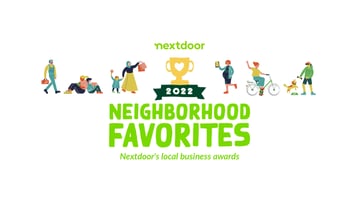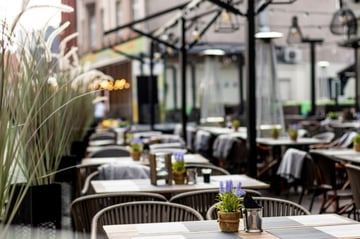Dining Out on Nextdoor: How Neighbors Are Choosing Where to Eat in 2025
The restaurant landscape has shifted dramatically over the past few years, and understanding how people decide where to dine out has never been more important for businesses trying to reach hungry customers. At Nextdoor, we wanted to understand the dining habits, preferences, and decision-making processes of our community members—the neighbors who are actively choosing where to eat multiple times a week.
We surveyed 1,000 U.S. adults in early October 2025 to get a clearer picture of dining behaviors, and what we found reveals significant opportunities for restaurants looking to connect with local audiences. From the power of community recommendations to the rising importance of convenience, here's what neighbors told us about how they're dining out today.
Recommendations and Ads on Nextdoor Drive Real Restaurant Visits
One of the most striking findings from our research is the influence that Nextdoor has on restaurant choice. Nearly three in five neighbors (59%) have considered purchasing from a quick-service restaurant (QSR) or casual dining establishment based on a recommendation they saw on Nextdoor—an 11% increase year-over-year. Half of neighbors (50%) have been influenced by advertisements they've seen on the platform.
This matters because Nextdoor isn't just another social network. It's a place where people actively seek advice from trusted sources in their own communities. When a neighbor recommends a new taco spot or warns about slow service at a local chain, those words carry weight. For restaurants, this creates a powerful opportunity to become part of the local conversation through both organic engagement and strategic advertising.
Neighbors Spend More on Dining Out—And They're Not Slowing Down
On average, Nextdoor users spend roughly $50 per week dining out, which is 11% more than the typical consumer. But here's what's particularly interesting: many neighbors are spending more than they did last year, and it's not just because prices have increased.
While higher prices are certainly a factor (59% of those spending more cited this as a reason), comfort (43%), rising grocery costs (38%), and busier schedules (37%) are also driving people to restaurants more frequently. In other words, dining out has become a practical solution for time-strapped households, not just an occasional indulgence.
Neighbors turn to restaurants most frequently for lunch and dinner, though breakfast is gaining traction—neighbors are 14% more likely than the general population to grab breakfast from a restaurant several times a week.
Summer and Holidays Are Peak Dining Seasons
Timing matters when it comes to restaurant marketing. According to our survey, 42% of neighbors say they dine out more frequently during the summer, making it the most popular season for increased restaurant visits. The holiday season comes in third at 29%, but here's the interesting part: neighbors are 21% more likely than the general population to increase their restaurant visits during the holidays.
For restaurants, this seasonal variation creates clear windows of opportunity. Summer campaigns can capitalize on vacation mindsets and relaxed schedules, while holiday promotions can capture families looking for convenient meal solutions during busy times.
Over Half of Neighbors Decide Where the Household Eats
When it comes to choosing where to eat, neighbors wield considerable influence within their households. Our research found that 53% of neighbors are typically responsible for deciding where their household purchases meals—10% more than the general population.
What drives their choices? Consistent quality and taste (42%), satisfying a craving (41%), and proximity to home (37%) are the top three factors. Discounts and promotions matter too (24%), as does speed of service (20%). Notably, neighbors are 19% more likely than the general population to consider proximity when choosing a restaurant.
This decision-making power, combined with the factors that influence restaurant choice, provides a roadmap for effective messaging. Restaurants that can demonstrate reliability, satisfy specific cravings, and emphasize their convenient location have a clear advantage.
In-Person Orders Still Dominate, But Online Is Growing
Despite the digital transformation of recent years, most neighbors (46%) still make all their restaurant purchases in person. However, online ordering is steadily gaining ground, with 70% of neighbors making at least some online purchases. Among those who order online, 60% usually do so through the restaurant's own site or app—an 18% increase year-over-year.
This shift toward direct ordering (rather than through third-party platforms) is significant. It suggests that customers value the streamlined experience and often better pricing that comes with ordering directly from restaurants. For restaurant operators, this reinforces the importance of investing in user-friendly ordering systems and promoting them effectively.
Why Neighbors Choose to Dine Out: Convenience Meets Cravings
Understanding why people choose restaurants over cooking at home reveals important motivations that restaurants can tap into. The top reason neighbors gave for dining out is simple: they didn't feel like cooking or wanted a break (47%). Close behind are craving a specific restaurant's food (44%) and wanting to treat themselves or their family (43%).
Convenience also plays a major role—41% said they were already out, making it more practical to order from a restaurant. Interestingly, neighbors are 17% more likely than the general population to cite this "already out" factor, suggesting that location-based marketing and visibility can be particularly effective for this audience.
Quick-Service vs. Casual Dining: A Slight Edge for Convenience
When asked about their preferences, neighbors showed a slight preference for quick-service restaurants (43%) over casual dining (38%), with many citing convenient ordering (62%), lower prices (54%), and reliable taste (40%) as the main draws.
Those who prefer casual dining point to greater menu variety (55%), higher food quality (54%), and a better overall dining atmosphere (52%). Interestingly, neighbors are about equally likely to choose national chains (26%) as local or independent restaurants (27%), with 47% having no preference.
What decides between chains and local spots? Neighbors choose national chains for consistency (63%), faster service (40%), and affordability (39%). They turn to local establishments for better quality (51%), to support their community (50%), and for more diverse menus (43%).
Promotions Inspire Action and Trial
Promotional offers have a meaningful impact on dining decisions. More than a third of neighbors (37%) say promotions motivate them to try new menu items, while 36% feel they provide significant savings, and 30% say promotions convince them to act spontaneously.
Notably, neighbors are 15% more likely than the general population to make spontaneous ordering decisions based on promotions. This responsiveness to limited-time offers and special deals creates opportunities for restaurants to drive incremental traffic through well-timed promotional campaigns.
Restaurants Are Seen as Part of the Community
Perhaps one of the most encouraging findings for restaurant operators is how neighbors view dining establishments in their area. A strong majority (69%) consider restaurants in their neighborhood to be part of the community, while 64% would like to see these restaurants do more to give back to local communities (a 10% increase year-over-year).
Additionally, 58% of neighbors feel that restaurants make it easier to connect with others in the community. This perception goes beyond transactions—it's about belonging and social connection. Restaurants that actively engage with their communities through sponsorships, partnerships, or local initiatives can strengthen these bonds and build lasting loyalty.
What Neighbors Are Saying on Nextdoor
Looking at actual conversations on the platform provides additional context. Among dining-related posts on Nextdoor from January through September 2025, restaurant reviews make up 21% of the conversation—by far the most common topic, and up 25% year-over-year. Neighbors are actively asking for and sharing restaurant suggestions, favorite spots, and dining experiences both positive and negative.
Other popular topics include delivery and takeout (5%), restaurant openings and closures (3%), general dining discussions (2%), and service experiences (2%). These conversations happen consistently throughout the year, with only slight variations by month, indicating that restaurant marketing should maintain a steady presence rather than relying on sporadic campaigns.
Geographically, neighbors in Florida, Nevada, and Illinois are most likely to discuss dining out, though the topic generates engagement across all states.
What This Means for Restaurant Marketers
The insights from this research point to several strategic opportunities for restaurants looking to connect with neighbors:
Reach decision-makers where they are. With over half of neighbors making household dining decisions and the majority influenced by recommendations and ads on Nextdoor, the platform offers direct access to the people who choose where families eat.
Time your campaigns strategically. Summer and the holiday season represent peak opportunities, but maintaining consistent presence matters too, as dining discussions happen year-round.
Lead with convenience and quality. Neighbors prioritize reliable taste, proximity, and convenient ordering. Make these benefits clear in your messaging, and invest in seamless ordering experiences through your own platforms.
Use promotions to drive trial and urgency. Limited-time offers and special deals resonate strongly with neighbors, particularly when they create a sense of spontaneity and encourage trying new items.
Emphasize community connection. Neighbors see restaurants as part of the fabric of their communities and want to see them actively giving back. Authentic community engagement isn't just good citizenship—it's good business.
Balance local authenticity with operational strengths. Whether you're a local independent or a national chain, lean into your specific advantages. Chains should emphasize consistency and value; local spots should highlight quality and community ties.
The dining landscape continues to shift, but one thing remains constant: people value convenience, quality, and connection. Restaurants that understand how neighbors make dining decisions and meet them with relevant, timely messaging will be best positioned to capture their attention and loyalty.
Want to explore the complete findings? This summary highlights key insights from our research, but there's much more to discover. For the full report with detailed data, additional audience segments, and strategic recommendations for your campaigns, reach out to Jacob Chavis, Customer Analytics & Insights Manager, at jchavis@nextdoor.com. Our team can help you apply these insights to reach high-intent neighbors at the moments that matter most.
Team Nextdoor
More from the blog
View All Posts.png?length=360&name=nextdoor-faves-highlights-us%20(1).png)
Introducing Faves: Harnessing the Collective Wisdom of Your Neighborhood
Read More
Celebrate the 2022 Neighborhood Favorites local business winners
Read More
How Do Americans Feel About Eating At Restaurants Right Now?
Read MoreSubscribe to email updates
Stay up-to-date on what's happening at this blog and get additional Nextdoor content.
